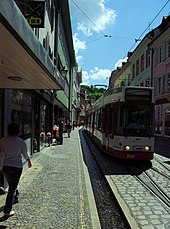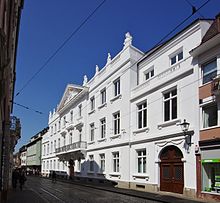Salt Road (Freiburg im Breisgau)
The Salt Road is a central part of the pedestrian zone in the center of Freiburg ; It stretches from Bertoldsbrunnen ▼ , where it meets Kaiser-Joseph-Straße , eastwards to Oberlinden square with the fountain of the same name ▼ . The oldest houses in Freiburg's old town were probably located here. On the northern side of the Salzstraße, a Freiburg stream runs between the tracks of tram line 1 and the sidewalk .
history
The name of the once important main street goes back to the time of the Zähringers , when the salt house was on this street. Here, the city sold the salt brought on wagons from Swabia to the citizens of Freiburg. The salt store was later moved to the old department store on Schusterstrasse; this was later extended in the direction of Münsterplatz and is now known as the historic department store ▼ , the municipal salt house was housed in the building next to it on Münsterplatz, the Redoutenhaus ▼ . The traffic from Swabia and the Zähringer towns to the east, leading over the Black Forest through the Höllental , came into the city via the Schwabentorbrücke ▼ and through the Schwabentor ▼ . The route via Freiburg was one of the most important east-west connections in the Breisgau . Before the city was founded, this trade route ran along the Dreisam from Umkirch to the east.
The Salzstrasse was originally called Salzgasse. The city's most important families had their city apartments here, including those of “von Ampringen”, “Brecht”, “von Falkenstein”, “von Keppenbach”, “von Krotzingen”, “Küchlin von Küchlinsbergen and von Küchlinsburg”, “Meinwart” von Tottikoven ”,“ Sneulin im Hof ”,“ Sneulin zur oberun lindun ”and“ Sneulin von Bollschweil, Wiesneck and Landeck ”. These families were able to advise and represented on the local council. From the middle of the 15th century, the names of the important families and thus the inhabitants of this street changed. Is known z. B. the prince abbot of St. Blasien , the von Blumenegg family and also the baron Ferdinand Sebastian von Sickingen-Hohenberg , who built the Sickingen-Palais ▼ here from 1769 to 1772 , which later became the grand ducal palace for the rulers of Baden .
In 1770, the Salzstrasse was briefly renamed Dauphinenstrasse when Marie Antoinette , the youngest daughter of Empress Maria Theresia and Emperor Franz I of Austria, was staying in the city on her wedding procession to the French court . She was on her way to the wedding with the future French King Louis XVI. who at that time was still Dauphin (Crown Prince). In Kageneckschen House ▼ in the salt street corner Drehergasse she took for two nights lodging, before continuing to the morning of May 6 Reichsabtei Schuttern traveled.
A linden tree that was planted in 1729 stands by the fountain on Oberlinden. A paving mosaic testifies to this. Since the tree is sick, it has to be felled and replaced with a new one. If possible, this should happen after the planned renewal of the tram tracks. Thanks to water and care, it was found in 2019 that the tree had recovered and, since the stability is guaranteed, will remain standing for the time being.
building
The Augustinermuseum ▼ , which is housed in the former monastery of the Augustinian hermits , is located on the Salzstrasse . The city archive ▼ is located in the building at Salzstrasse 18. The building dates from the 16th century and was built by councilor Hans Graf. The original name was "To the White Cross" until it was renamed to the Duke in 1565 because of the portal figure . It stands on the foundation of what is probably the oldest house in Freiburg (1120). The access to the city archive is in Grünwälderstraße ▼ .
Until the destruction of the Freiburg city center by bombs in November 1944 , the "Große Meyerhof" extended from Grünwälderstraße ▼ to Salzstraße. The inn was founded in 1885 by Wilhelm Meyer, a beer brewer from Riegel . Several older buildings were rebuilt and combined.
In the Sickingen Palais on the north side of the street, a classicist building by the architect Pierre Michel d'Ixnard , built between 1769 and 1773 , the Freiburg Regional Court is now located . The building burned down in 1944 and was rebuilt from 1962 to 1965, only the facade was reconstructed, but the interior was designed in a contemporary way for the intended use as a courthouse.
Opposite the Sickingen Palais, another historic building is also used for the judiciary: In the former Kommende ▼ of the Teutonic Order there are civil senates of the Karlsruhe Higher Regional Court and chambers of the Freiburg Regional Court. The building was built from 1768 to 1773 in the Baroque style according to plans by Franz Anton Bagnato , who mainly worked for the Teutonic Order. This building also burned out in 1944 and was rebuilt from 1982–1986, also with the reconstruction of only the facade, whereby the original parts could be used. Both buildings, built at the same time in different styles and of roughly the same size, relate to each other. 47.994684, 7.850429 The Kagenecksche Haus ▼ zum wilden Mann is located on the corner of Drehergasse and is first mentioned around 1460. In the 16th century it was owned by the Schnewlin von Landeck , then an inn and owned by the Mayer family. It was acquired in 1733 by the Austrian court chamber president JH von Kageneck, destroyed in 1944 and rebuilt in 1952 in a historicizing form.
On the house at Salzstraße 51 ▼ you can still discover a gable with a bell tower that belonged to the former Antoniterhaus. The Antonite Brotherhood had been nursing the sick there since 1347 . It was abandoned around 1635 and converted into a benefice house. The church was profaned in 1790.
On the Oberlinden square, which lies between the Salzstrasse and the Schwabentor, you will find one of the oldest inns in Germany, the Zum Roten Bären ▼ .
The customer center of the Freiburger Verkehrs AG is located opposite the Bertoldsbrunnen tram stop on line 1 in the direction of Littenweiler .
literature
- Manfred Gallo: Domicile of the Grand Dukes of Baden. In: Badische Zeitung. February 21, 2011.
- Peter Kalchthaler : Freiburg and its buildings. An art-historical city tour. Revised 4th edition. Promo-Verlag, Freiburg (Breisgau) 2006, ISBN 3-923288-45-X .
Individual evidence
- ^ La dernière Reine de France ( Memento from January 5, 2011 in the Internet Archive ) Chapter 1.2 The bridal procession to France.
- ^ Peter Kalchthaler : Freiburg center: Triumphal Arch in the Kaiserstraße . in: Badische Zeitung of May 3, 2010, accessed December 30, 2010.
- ↑ Simone Lutz: Freiburg: The days of the Oberlinden-Linden are numbered. Badische Zeitung, December 29, 2016, accessed on December 29, 2016 .
- ↑ Simone Lutz: The upper linden-lime tree is allowed to stand still for the time being - although terminally ill. Badische Zeitung, June 17, 2019, accessed on June 18, 2019 .
- ↑ Peter Kalchthaler: Freiburg and its buildings, an art-historical city tour. Promo Verlag, Freiburg 2006.
- ↑ Freiburg City Archives, F Talvogtei Specialia XV Zinken und Einzelhoefe (PDF; 16 kB)
Web links
- Salt road Freiburg. Baden pages





